Report: Analyzing Organizational Behaviour at Marks and Spencer
VerifiedAdded on 2023/01/11
|17
|4264
|61
Report
AI Summary
This report provides an analysis of organizational behaviour within the context of Marks and Spencer (M&S). It begins with an introduction to organizational behaviour, highlighting the challenges M&S faces, such as high staff turnover. The report then delves into the influence of organizational culture, politics, and power on employee behaviour, using Handy's model and Hofstede's cultural dimensions to analyze the organizational context. It examines different types of power within the organization, including legitimate, reward, expert, referent, and coercive power. Furthermore, the report explores motivation theories, including Herzberg's Two-Factor Theory, Maslow's Hierarchy of Needs, Adam's Equity Theory, and Vroom's Expectancy Theory, to understand how to motivate employees and improve team performance. The report also discusses Belbin's team roles and their application within M&S. Finally, it touches on the path-goal theory of leadership. The report concludes with a summary of the findings and references.
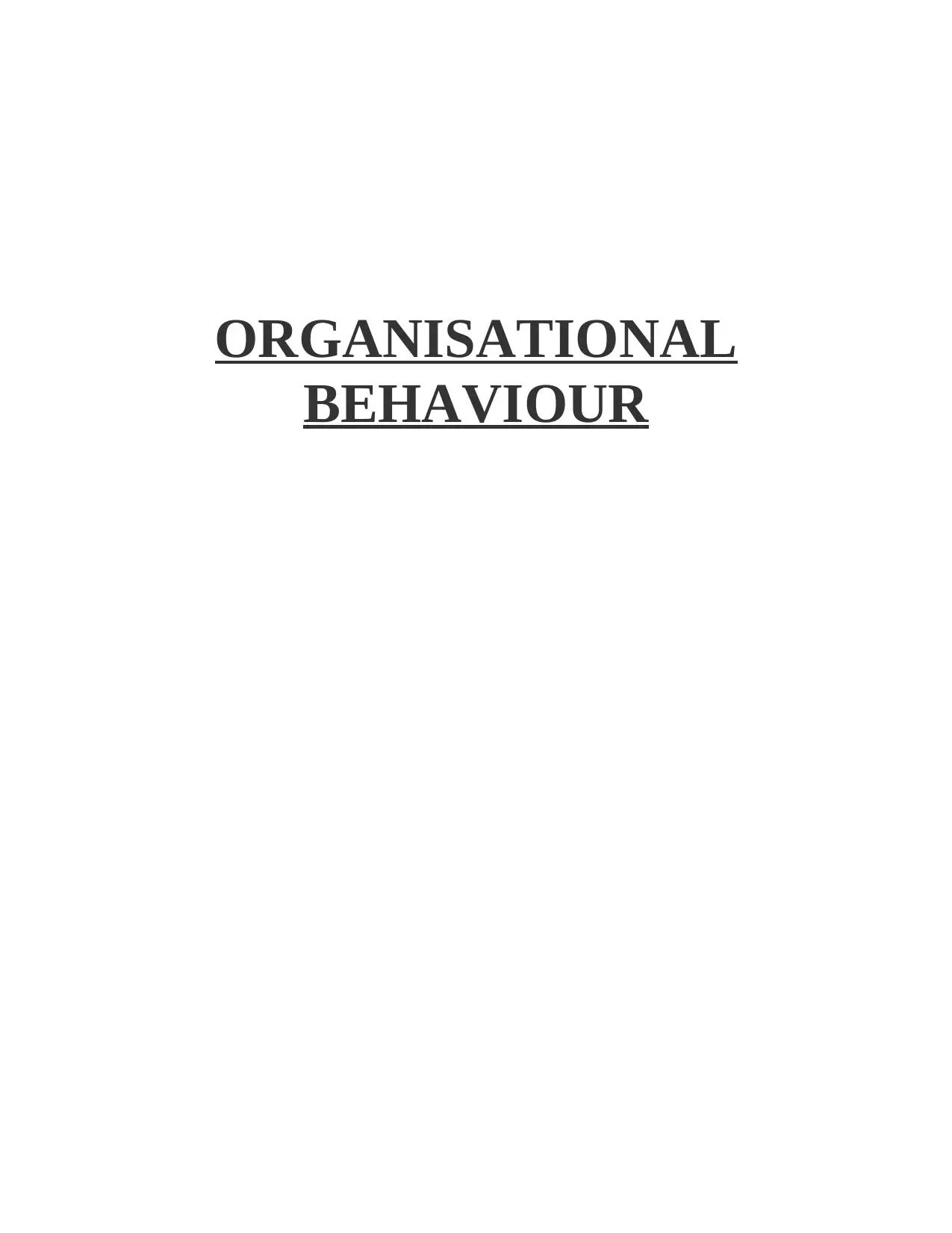
ORGANISATIONAL
BEHAVIOUR
BEHAVIOUR
Paraphrase This Document
Need a fresh take? Get an instant paraphrase of this document with our AI Paraphraser

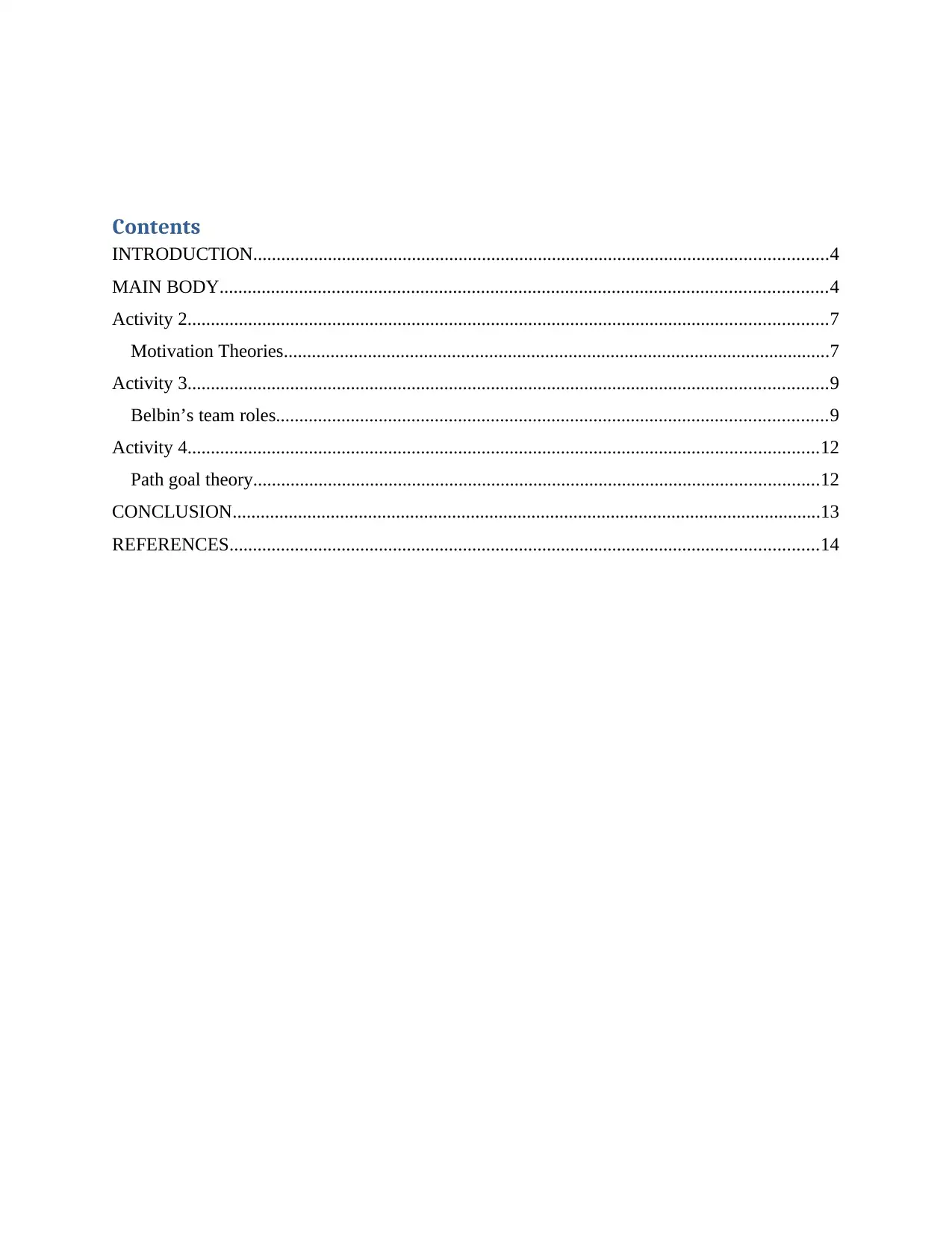
Contents
INTRODUCTION...........................................................................................................................4
MAIN BODY..................................................................................................................................4
Activity 2.........................................................................................................................................7
Motivation Theories.....................................................................................................................7
Activity 3.........................................................................................................................................9
Belbin’s team roles......................................................................................................................9
Activity 4.......................................................................................................................................12
Path goal theory.........................................................................................................................12
CONCLUSION..............................................................................................................................13
REFERENCES..............................................................................................................................14
INTRODUCTION...........................................................................................................................4
MAIN BODY..................................................................................................................................4
Activity 2.........................................................................................................................................7
Motivation Theories.....................................................................................................................7
Activity 3.........................................................................................................................................9
Belbin’s team roles......................................................................................................................9
Activity 4.......................................................................................................................................12
Path goal theory.........................................................................................................................12
CONCLUSION..............................................................................................................................13
REFERENCES..............................................................................................................................14
⊘ This is a preview!⊘
Do you want full access?
Subscribe today to unlock all pages.

Trusted by 1+ million students worldwide
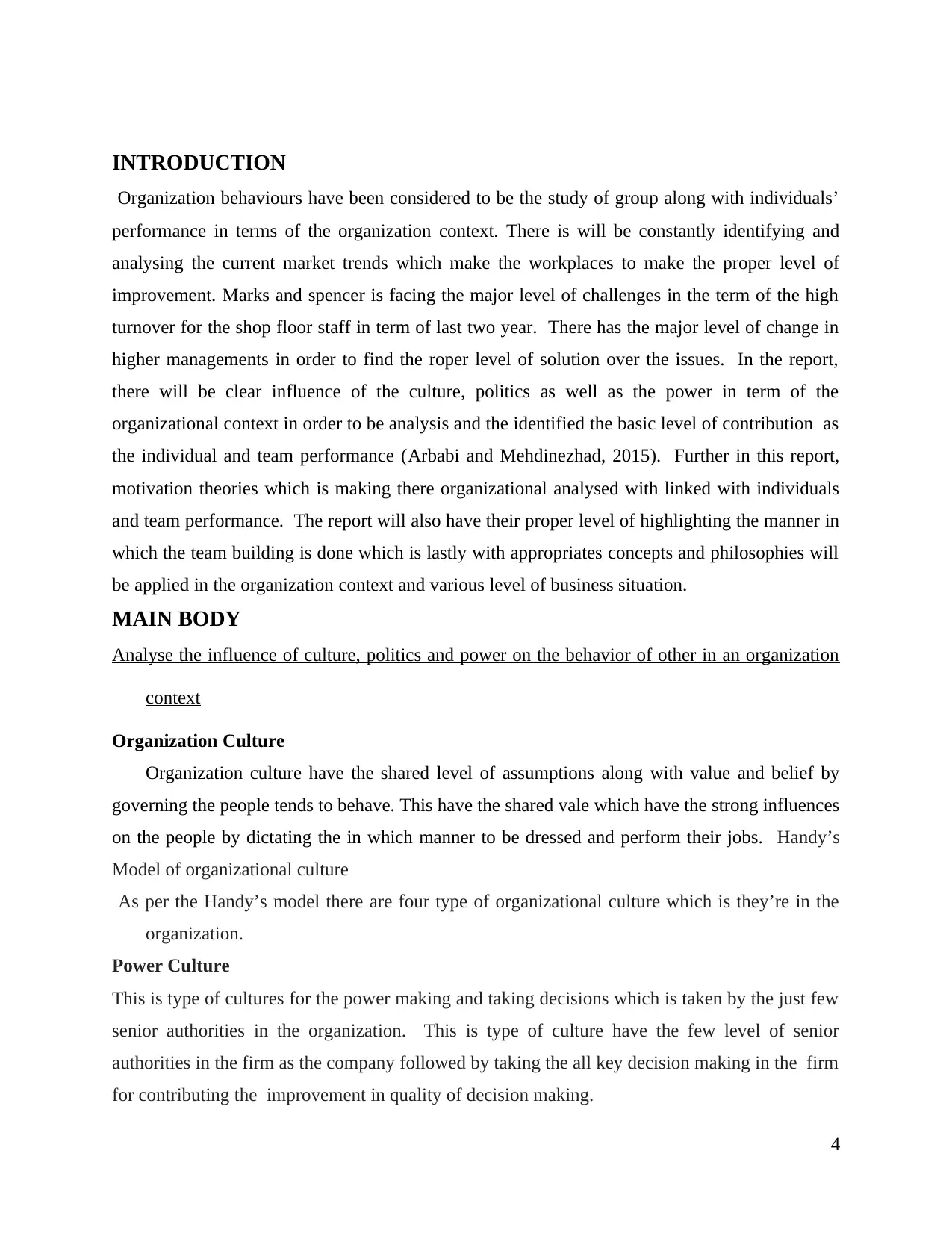
INTRODUCTION
Organization behaviours have been considered to be the study of group along with individuals’
performance in terms of the organization context. There is will be constantly identifying and
analysing the current market trends which make the workplaces to make the proper level of
improvement. Marks and spencer is facing the major level of challenges in the term of the high
turnover for the shop floor staff in term of last two year. There has the major level of change in
higher managements in order to find the roper level of solution over the issues. In the report,
there will be clear influence of the culture, politics as well as the power in term of the
organizational context in order to be analysis and the identified the basic level of contribution as
the individual and team performance (Arbabi and Mehdinezhad, 2015). Further in this report,
motivation theories which is making there organizational analysed with linked with individuals
and team performance. The report will also have their proper level of highlighting the manner in
which the team building is done which is lastly with appropriates concepts and philosophies will
be applied in the organization context and various level of business situation.
MAIN BODY
Analyse the influence of culture, politics and power on the behavior of other in an organization
context
Organization Culture
Organization culture have the shared level of assumptions along with value and belief by
governing the people tends to behave. This have the shared vale which have the strong influences
on the people by dictating the in which manner to be dressed and perform their jobs. Handy’s
Model of organizational culture
As per the Handy’s model there are four type of organizational culture which is they’re in the
organization.
Power Culture
This is type of cultures for the power making and taking decisions which is taken by the just few
senior authorities in the organization. This is type of culture have the few level of senior
authorities in the firm as the company followed by taking the all key decision making in the firm
for contributing the improvement in quality of decision making.
4
Organization behaviours have been considered to be the study of group along with individuals’
performance in terms of the organization context. There is will be constantly identifying and
analysing the current market trends which make the workplaces to make the proper level of
improvement. Marks and spencer is facing the major level of challenges in the term of the high
turnover for the shop floor staff in term of last two year. There has the major level of change in
higher managements in order to find the roper level of solution over the issues. In the report,
there will be clear influence of the culture, politics as well as the power in term of the
organizational context in order to be analysis and the identified the basic level of contribution as
the individual and team performance (Arbabi and Mehdinezhad, 2015). Further in this report,
motivation theories which is making there organizational analysed with linked with individuals
and team performance. The report will also have their proper level of highlighting the manner in
which the team building is done which is lastly with appropriates concepts and philosophies will
be applied in the organization context and various level of business situation.
MAIN BODY
Analyse the influence of culture, politics and power on the behavior of other in an organization
context
Organization Culture
Organization culture have the shared level of assumptions along with value and belief by
governing the people tends to behave. This have the shared vale which have the strong influences
on the people by dictating the in which manner to be dressed and perform their jobs. Handy’s
Model of organizational culture
As per the Handy’s model there are four type of organizational culture which is they’re in the
organization.
Power Culture
This is type of cultures for the power making and taking decisions which is taken by the just few
senior authorities in the organization. This is type of culture have the few level of senior
authorities in the firm as the company followed by taking the all key decision making in the firm
for contributing the improvement in quality of decision making.
4
Paraphrase This Document
Need a fresh take? Get an instant paraphrase of this document with our AI Paraphraser
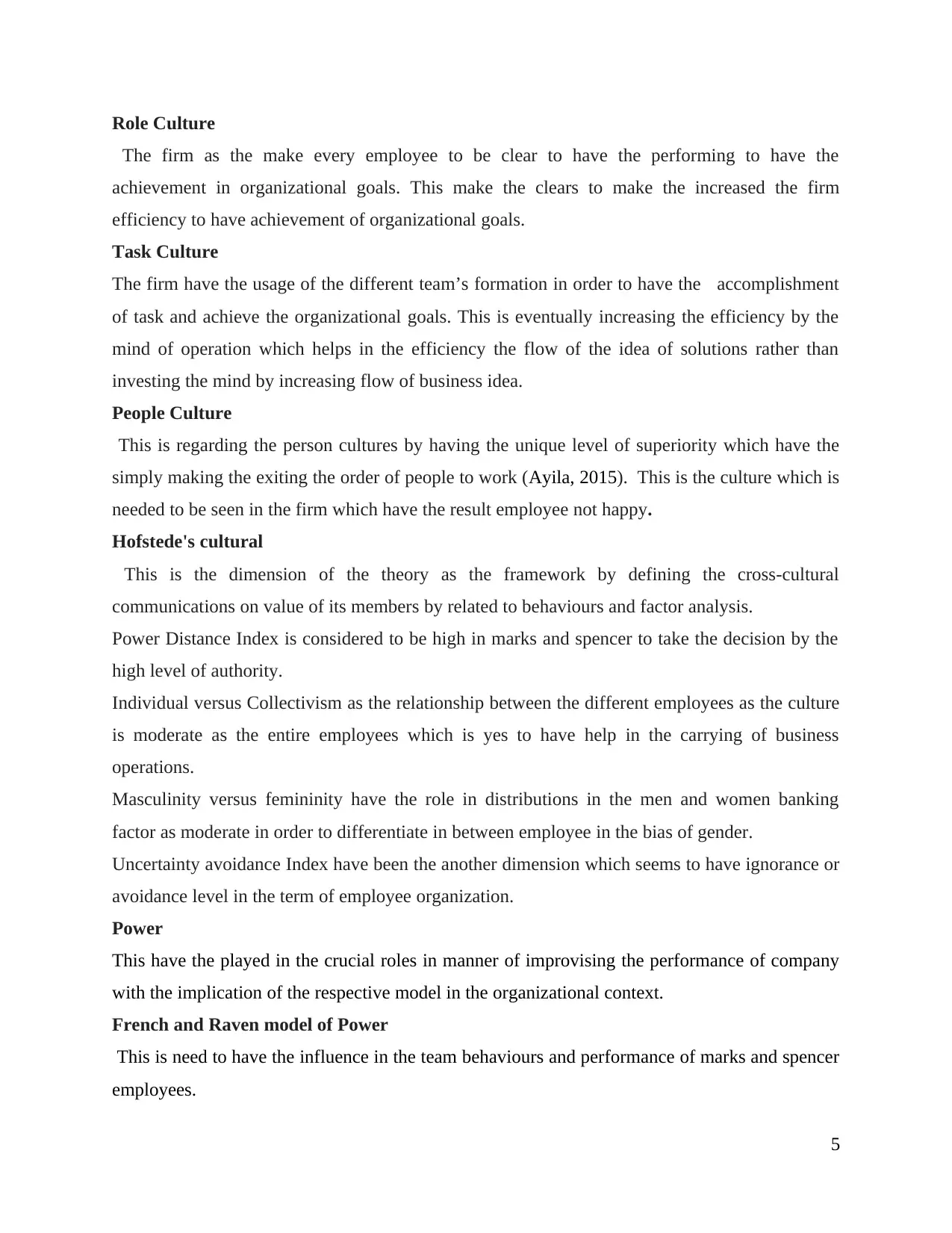
Role Culture
The firm as the make every employee to be clear to have the performing to have the
achievement in organizational goals. This make the clears to make the increased the firm
efficiency to have achievement of organizational goals.
Task Culture
The firm have the usage of the different team’s formation in order to have the accomplishment
of task and achieve the organizational goals. This is eventually increasing the efficiency by the
mind of operation which helps in the efficiency the flow of the idea of solutions rather than
investing the mind by increasing flow of business idea.
People Culture
This is regarding the person cultures by having the unique level of superiority which have the
simply making the exiting the order of people to work (Ayila, 2015). This is the culture which is
needed to be seen in the firm which have the result employee not happy.
Hofstede's cultural
This is the dimension of the theory as the framework by defining the cross-cultural
communications on value of its members by related to behaviours and factor analysis.
Power Distance Index is considered to be high in marks and spencer to take the decision by the
high level of authority.
Individual versus Collectivism as the relationship between the different employees as the culture
is moderate as the entire employees which is yes to have help in the carrying of business
operations.
Masculinity versus femininity have the role in distributions in the men and women banking
factor as moderate in order to differentiate in between employee in the bias of gender.
Uncertainty avoidance Index have been the another dimension which seems to have ignorance or
avoidance level in the term of employee organization.
Power
This have the played in the crucial roles in manner of improvising the performance of company
with the implication of the respective model in the organizational context.
French and Raven model of Power
This is need to have the influence in the team behaviours and performance of marks and spencer
employees.
5
The firm as the make every employee to be clear to have the performing to have the
achievement in organizational goals. This make the clears to make the increased the firm
efficiency to have achievement of organizational goals.
Task Culture
The firm have the usage of the different team’s formation in order to have the accomplishment
of task and achieve the organizational goals. This is eventually increasing the efficiency by the
mind of operation which helps in the efficiency the flow of the idea of solutions rather than
investing the mind by increasing flow of business idea.
People Culture
This is regarding the person cultures by having the unique level of superiority which have the
simply making the exiting the order of people to work (Ayila, 2015). This is the culture which is
needed to be seen in the firm which have the result employee not happy.
Hofstede's cultural
This is the dimension of the theory as the framework by defining the cross-cultural
communications on value of its members by related to behaviours and factor analysis.
Power Distance Index is considered to be high in marks and spencer to take the decision by the
high level of authority.
Individual versus Collectivism as the relationship between the different employees as the culture
is moderate as the entire employees which is yes to have help in the carrying of business
operations.
Masculinity versus femininity have the role in distributions in the men and women banking
factor as moderate in order to differentiate in between employee in the bias of gender.
Uncertainty avoidance Index have been the another dimension which seems to have ignorance or
avoidance level in the term of employee organization.
Power
This have the played in the crucial roles in manner of improvising the performance of company
with the implication of the respective model in the organizational context.
French and Raven model of Power
This is need to have the influence in the team behaviours and performance of marks and spencer
employees.
5
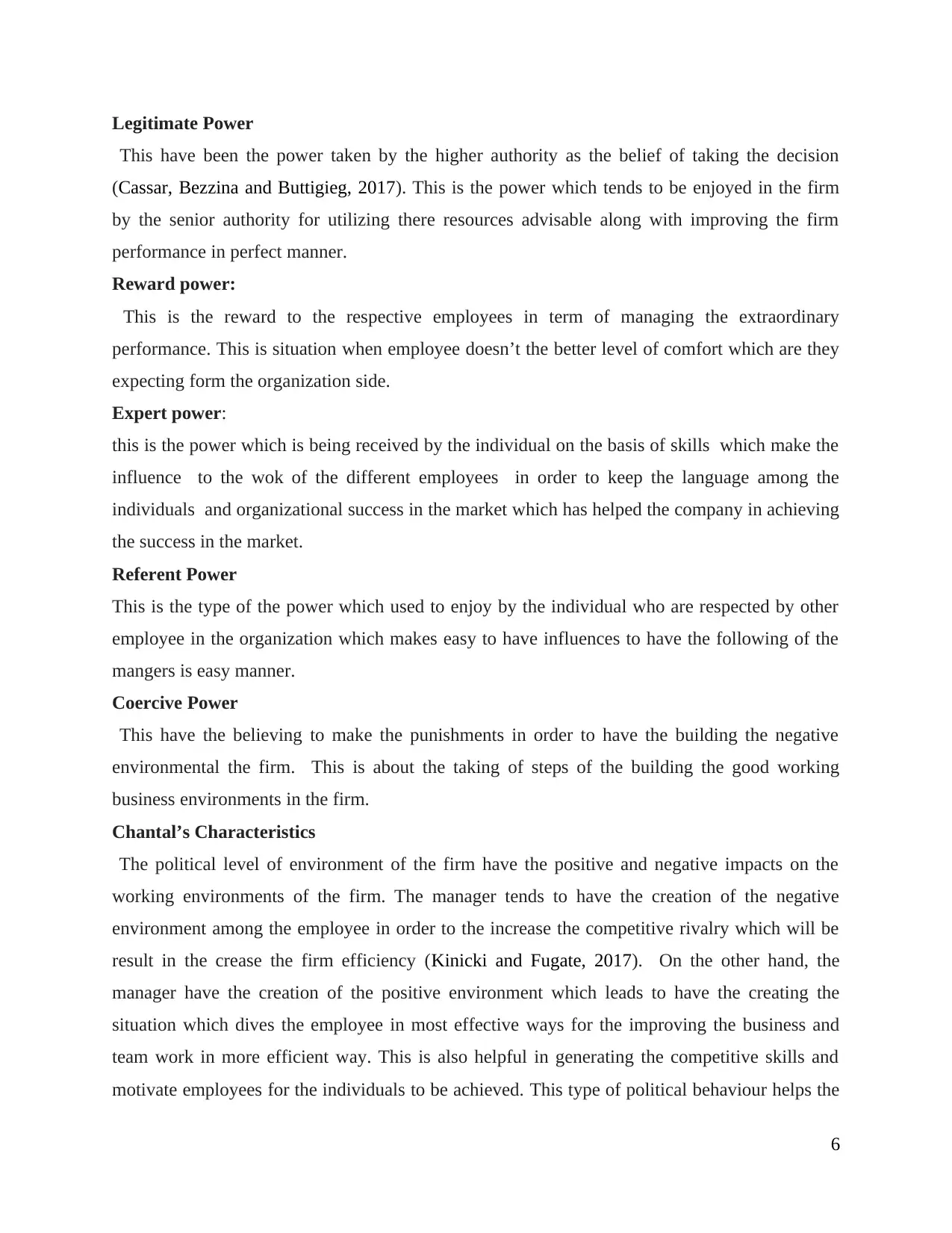
Legitimate Power
This have been the power taken by the higher authority as the belief of taking the decision
(Cassar, Bezzina and Buttigieg, 2017). This is the power which tends to be enjoyed in the firm
by the senior authority for utilizing there resources advisable along with improving the firm
performance in perfect manner.
Reward power:
This is the reward to the respective employees in term of managing the extraordinary
performance. This is situation when employee doesn’t the better level of comfort which are they
expecting form the organization side.
Expert power:
this is the power which is being received by the individual on the basis of skills which make the
influence to the wok of the different employees in order to keep the language among the
individuals and organizational success in the market which has helped the company in achieving
the success in the market.
Referent Power
This is the type of the power which used to enjoy by the individual who are respected by other
employee in the organization which makes easy to have influences to have the following of the
mangers is easy manner.
Coercive Power
This have the believing to make the punishments in order to have the building the negative
environmental the firm. This is about the taking of steps of the building the good working
business environments in the firm.
Chantal’s Characteristics
The political level of environment of the firm have the positive and negative impacts on the
working environments of the firm. The manager tends to have the creation of the negative
environment among the employee in order to the increase the competitive rivalry which will be
result in the crease the firm efficiency (Kinicki and Fugate, 2017). On the other hand, the
manager have the creation of the positive environment which leads to have the creating the
situation which dives the employee in most effective ways for the improving the business and
team work in more efficient way. This is also helpful in generating the competitive skills and
motivate employees for the individuals to be achieved. This type of political behaviour helps the
6
This have been the power taken by the higher authority as the belief of taking the decision
(Cassar, Bezzina and Buttigieg, 2017). This is the power which tends to be enjoyed in the firm
by the senior authority for utilizing there resources advisable along with improving the firm
performance in perfect manner.
Reward power:
This is the reward to the respective employees in term of managing the extraordinary
performance. This is situation when employee doesn’t the better level of comfort which are they
expecting form the organization side.
Expert power:
this is the power which is being received by the individual on the basis of skills which make the
influence to the wok of the different employees in order to keep the language among the
individuals and organizational success in the market which has helped the company in achieving
the success in the market.
Referent Power
This is the type of the power which used to enjoy by the individual who are respected by other
employee in the organization which makes easy to have influences to have the following of the
mangers is easy manner.
Coercive Power
This have the believing to make the punishments in order to have the building the negative
environmental the firm. This is about the taking of steps of the building the good working
business environments in the firm.
Chantal’s Characteristics
The political level of environment of the firm have the positive and negative impacts on the
working environments of the firm. The manager tends to have the creation of the negative
environment among the employee in order to the increase the competitive rivalry which will be
result in the crease the firm efficiency (Kinicki and Fugate, 2017). On the other hand, the
manager have the creation of the positive environment which leads to have the creating the
situation which dives the employee in most effective ways for the improving the business and
team work in more efficient way. This is also helpful in generating the competitive skills and
motivate employees for the individuals to be achieved. This type of political behaviour helps the
6
⊘ This is a preview!⊘
Do you want full access?
Subscribe today to unlock all pages.

Trusted by 1+ million students worldwide
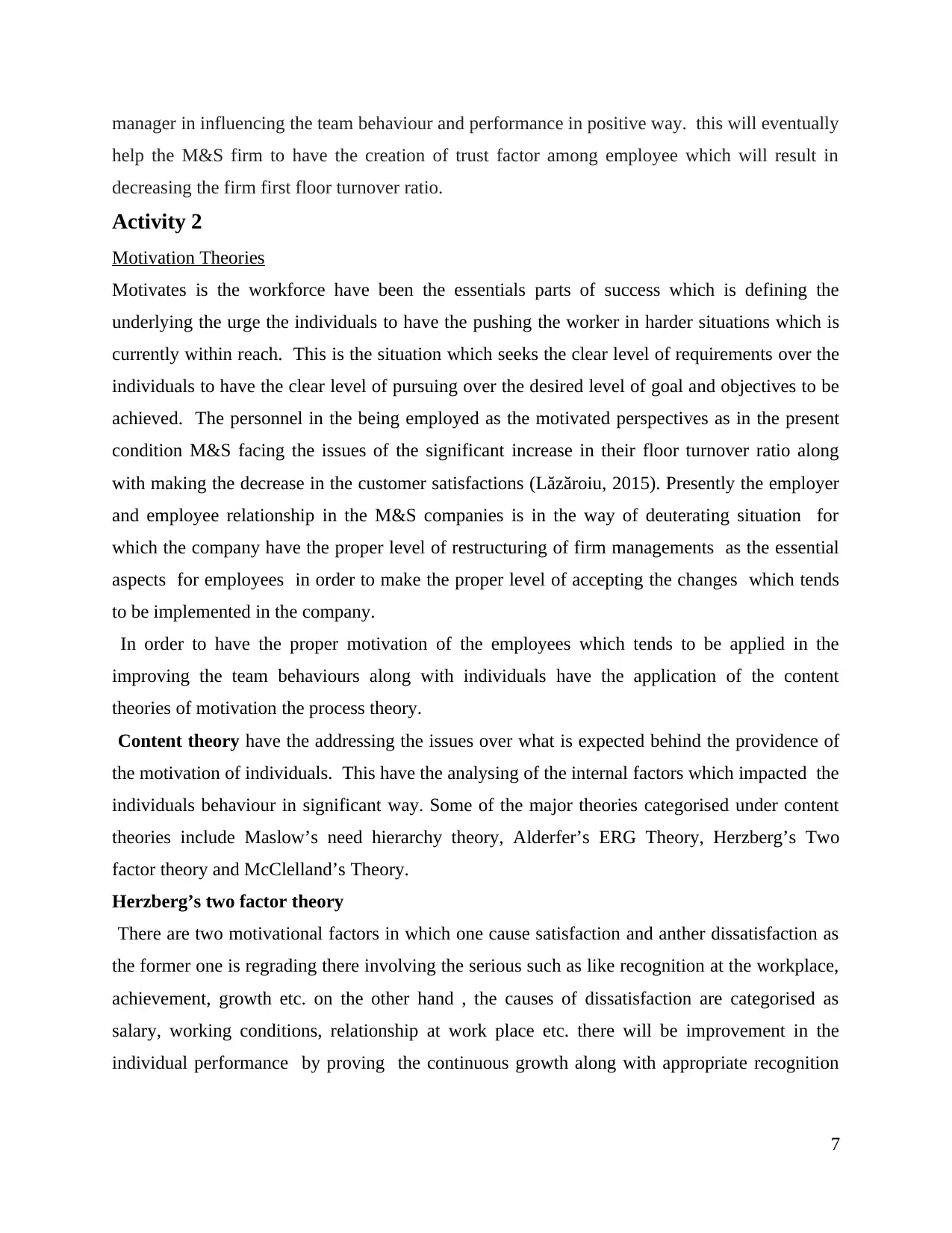
manager in influencing the team behaviour and performance in positive way. this will eventually
help the M&S firm to have the creation of trust factor among employee which will result in
decreasing the firm first floor turnover ratio.
Activity 2
Motivation Theories
Motivates is the workforce have been the essentials parts of success which is defining the
underlying the urge the individuals to have the pushing the worker in harder situations which is
currently within reach. This is the situation which seeks the clear level of requirements over the
individuals to have the clear level of pursuing over the desired level of goal and objectives to be
achieved. The personnel in the being employed as the motivated perspectives as in the present
condition M&S facing the issues of the significant increase in their floor turnover ratio along
with making the decrease in the customer satisfactions (Lăzăroiu, 2015). Presently the employer
and employee relationship in the M&S companies is in the way of deuterating situation for
which the company have the proper level of restructuring of firm managements as the essential
aspects for employees in order to make the proper level of accepting the changes which tends
to be implemented in the company.
In order to have the proper motivation of the employees which tends to be applied in the
improving the team behaviours along with individuals have the application of the content
theories of motivation the process theory.
Content theory have the addressing the issues over what is expected behind the providence of
the motivation of individuals. This have the analysing of the internal factors which impacted the
individuals behaviour in significant way. Some of the major theories categorised under content
theories include Maslow’s need hierarchy theory, Alderfer’s ERG Theory, Herzberg’s Two
factor theory and McClelland’s Theory.
Herzberg’s two factor theory
There are two motivational factors in which one cause satisfaction and anther dissatisfaction as
the former one is regrading there involving the serious such as like recognition at the workplace,
achievement, growth etc. on the other hand , the causes of dissatisfaction are categorised as
salary, working conditions, relationship at work place etc. there will be improvement in the
individual performance by proving the continuous growth along with appropriate recognition
7
help the M&S firm to have the creation of trust factor among employee which will result in
decreasing the firm first floor turnover ratio.
Activity 2
Motivation Theories
Motivates is the workforce have been the essentials parts of success which is defining the
underlying the urge the individuals to have the pushing the worker in harder situations which is
currently within reach. This is the situation which seeks the clear level of requirements over the
individuals to have the clear level of pursuing over the desired level of goal and objectives to be
achieved. The personnel in the being employed as the motivated perspectives as in the present
condition M&S facing the issues of the significant increase in their floor turnover ratio along
with making the decrease in the customer satisfactions (Lăzăroiu, 2015). Presently the employer
and employee relationship in the M&S companies is in the way of deuterating situation for
which the company have the proper level of restructuring of firm managements as the essential
aspects for employees in order to make the proper level of accepting the changes which tends
to be implemented in the company.
In order to have the proper motivation of the employees which tends to be applied in the
improving the team behaviours along with individuals have the application of the content
theories of motivation the process theory.
Content theory have the addressing the issues over what is expected behind the providence of
the motivation of individuals. This have the analysing of the internal factors which impacted the
individuals behaviour in significant way. Some of the major theories categorised under content
theories include Maslow’s need hierarchy theory, Alderfer’s ERG Theory, Herzberg’s Two
factor theory and McClelland’s Theory.
Herzberg’s two factor theory
There are two motivational factors in which one cause satisfaction and anther dissatisfaction as
the former one is regrading there involving the serious such as like recognition at the workplace,
achievement, growth etc. on the other hand , the causes of dissatisfaction are categorised as
salary, working conditions, relationship at work place etc. there will be improvement in the
individual performance by proving the continuous growth along with appropriate recognition
7
Paraphrase This Document
Need a fresh take? Get an instant paraphrase of this document with our AI Paraphraser
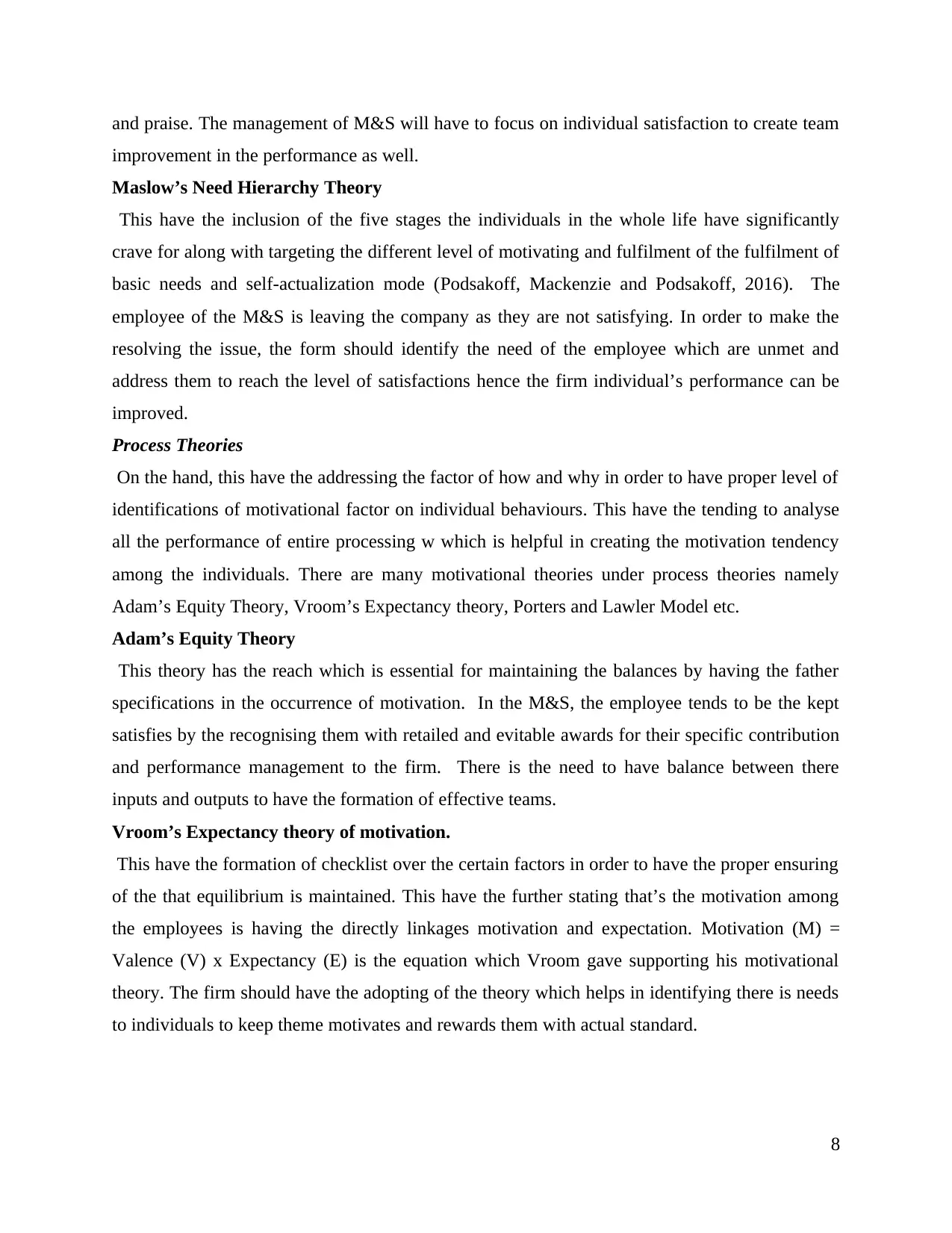
and praise. The management of M&S will have to focus on individual satisfaction to create team
improvement in the performance as well.
Maslow’s Need Hierarchy Theory
This have the inclusion of the five stages the individuals in the whole life have significantly
crave for along with targeting the different level of motivating and fulfilment of the fulfilment of
basic needs and self-actualization mode (Podsakoff, Mackenzie and Podsakoff, 2016). The
employee of the M&S is leaving the company as they are not satisfying. In order to make the
resolving the issue, the form should identify the need of the employee which are unmet and
address them to reach the level of satisfactions hence the firm individual’s performance can be
improved.
Process Theories
On the hand, this have the addressing the factor of how and why in order to have proper level of
identifications of motivational factor on individual behaviours. This have the tending to analyse
all the performance of entire processing w which is helpful in creating the motivation tendency
among the individuals. There are many motivational theories under process theories namely
Adam’s Equity Theory, Vroom’s Expectancy theory, Porters and Lawler Model etc.
Adam’s Equity Theory
This theory has the reach which is essential for maintaining the balances by having the father
specifications in the occurrence of motivation. In the M&S, the employee tends to be the kept
satisfies by the recognising them with retailed and evitable awards for their specific contribution
and performance management to the firm. There is the need to have balance between there
inputs and outputs to have the formation of effective teams.
Vroom’s Expectancy theory of motivation.
This have the formation of checklist over the certain factors in order to have the proper ensuring
of the that equilibrium is maintained. This have the further stating that’s the motivation among
the employees is having the directly linkages motivation and expectation. Motivation (M) =
Valence (V) x Expectancy (E) is the equation which Vroom gave supporting his motivational
theory. The firm should have the adopting of the theory which helps in identifying there is needs
to individuals to keep theme motivates and rewards them with actual standard.
8
improvement in the performance as well.
Maslow’s Need Hierarchy Theory
This have the inclusion of the five stages the individuals in the whole life have significantly
crave for along with targeting the different level of motivating and fulfilment of the fulfilment of
basic needs and self-actualization mode (Podsakoff, Mackenzie and Podsakoff, 2016). The
employee of the M&S is leaving the company as they are not satisfying. In order to make the
resolving the issue, the form should identify the need of the employee which are unmet and
address them to reach the level of satisfactions hence the firm individual’s performance can be
improved.
Process Theories
On the hand, this have the addressing the factor of how and why in order to have proper level of
identifications of motivational factor on individual behaviours. This have the tending to analyse
all the performance of entire processing w which is helpful in creating the motivation tendency
among the individuals. There are many motivational theories under process theories namely
Adam’s Equity Theory, Vroom’s Expectancy theory, Porters and Lawler Model etc.
Adam’s Equity Theory
This theory has the reach which is essential for maintaining the balances by having the father
specifications in the occurrence of motivation. In the M&S, the employee tends to be the kept
satisfies by the recognising them with retailed and evitable awards for their specific contribution
and performance management to the firm. There is the need to have balance between there
inputs and outputs to have the formation of effective teams.
Vroom’s Expectancy theory of motivation.
This have the formation of checklist over the certain factors in order to have the proper ensuring
of the that equilibrium is maintained. This have the further stating that’s the motivation among
the employees is having the directly linkages motivation and expectation. Motivation (M) =
Valence (V) x Expectancy (E) is the equation which Vroom gave supporting his motivational
theory. The firm should have the adopting of the theory which helps in identifying there is needs
to individuals to keep theme motivates and rewards them with actual standard.
8
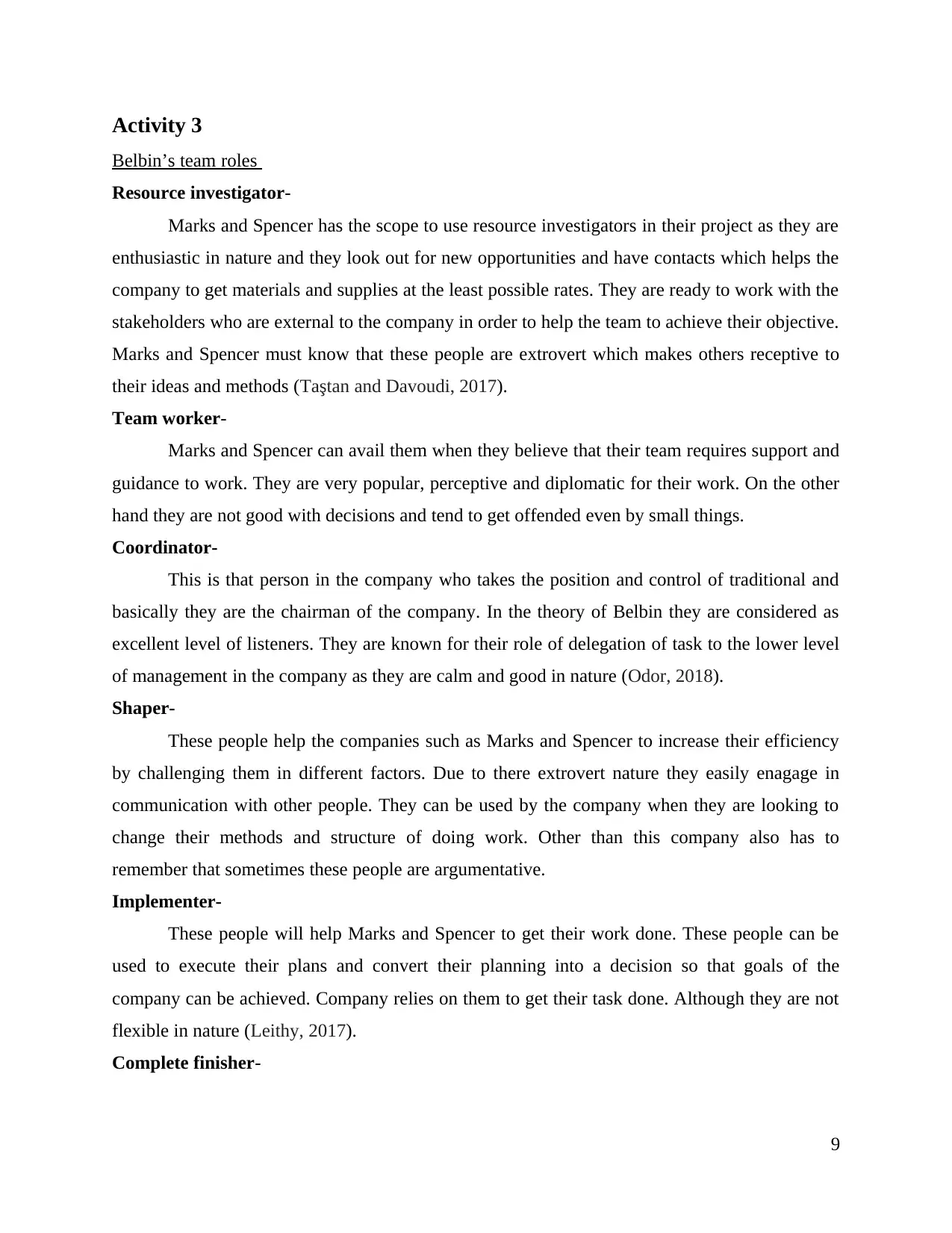
Activity 3
Belbin’s team roles
Resource investigator-
Marks and Spencer has the scope to use resource investigators in their project as they are
enthusiastic in nature and they look out for new opportunities and have contacts which helps the
company to get materials and supplies at the least possible rates. They are ready to work with the
stakeholders who are external to the company in order to help the team to achieve their objective.
Marks and Spencer must know that these people are extrovert which makes others receptive to
their ideas and methods (Taştan and Davoudi, 2017).
Team worker-
Marks and Spencer can avail them when they believe that their team requires support and
guidance to work. They are very popular, perceptive and diplomatic for their work. On the other
hand they are not good with decisions and tend to get offended even by small things.
Coordinator-
This is that person in the company who takes the position and control of traditional and
basically they are the chairman of the company. In the theory of Belbin they are considered as
excellent level of listeners. They are known for their role of delegation of task to the lower level
of management in the company as they are calm and good in nature (Odor, 2018).
Shaper-
These people help the companies such as Marks and Spencer to increase their efficiency
by challenging them in different factors. Due to there extrovert nature they easily enagage in
communication with other people. They can be used by the company when they are looking to
change their methods and structure of doing work. Other than this company also has to
remember that sometimes these people are argumentative.
Implementer-
These people will help Marks and Spencer to get their work done. These people can be
used to execute their plans and convert their planning into a decision so that goals of the
company can be achieved. Company relies on them to get their task done. Although they are not
flexible in nature (Leithy, 2017).
Complete finisher-
9
Belbin’s team roles
Resource investigator-
Marks and Spencer has the scope to use resource investigators in their project as they are
enthusiastic in nature and they look out for new opportunities and have contacts which helps the
company to get materials and supplies at the least possible rates. They are ready to work with the
stakeholders who are external to the company in order to help the team to achieve their objective.
Marks and Spencer must know that these people are extrovert which makes others receptive to
their ideas and methods (Taştan and Davoudi, 2017).
Team worker-
Marks and Spencer can avail them when they believe that their team requires support and
guidance to work. They are very popular, perceptive and diplomatic for their work. On the other
hand they are not good with decisions and tend to get offended even by small things.
Coordinator-
This is that person in the company who takes the position and control of traditional and
basically they are the chairman of the company. In the theory of Belbin they are considered as
excellent level of listeners. They are known for their role of delegation of task to the lower level
of management in the company as they are calm and good in nature (Odor, 2018).
Shaper-
These people help the companies such as Marks and Spencer to increase their efficiency
by challenging them in different factors. Due to there extrovert nature they easily enagage in
communication with other people. They can be used by the company when they are looking to
change their methods and structure of doing work. Other than this company also has to
remember that sometimes these people are argumentative.
Implementer-
These people will help Marks and Spencer to get their work done. These people can be
used to execute their plans and convert their planning into a decision so that goals of the
company can be achieved. Company relies on them to get their task done. Although they are not
flexible in nature (Leithy, 2017).
Complete finisher-
9
⊘ This is a preview!⊘
Do you want full access?
Subscribe today to unlock all pages.

Trusted by 1+ million students worldwide
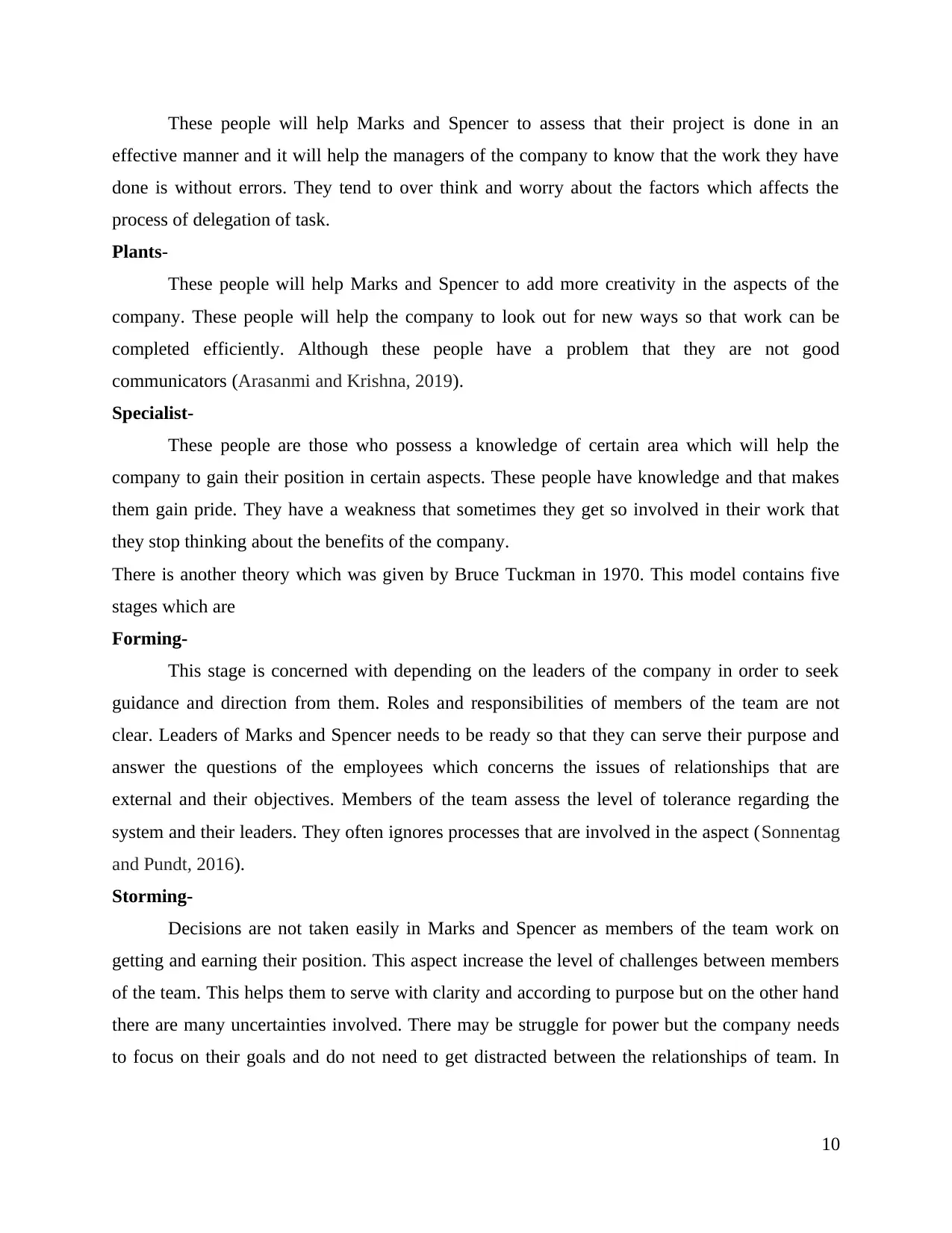
These people will help Marks and Spencer to assess that their project is done in an
effective manner and it will help the managers of the company to know that the work they have
done is without errors. They tend to over think and worry about the factors which affects the
process of delegation of task.
Plants-
These people will help Marks and Spencer to add more creativity in the aspects of the
company. These people will help the company to look out for new ways so that work can be
completed efficiently. Although these people have a problem that they are not good
communicators (Arasanmi and Krishna, 2019).
Specialist-
These people are those who possess a knowledge of certain area which will help the
company to gain their position in certain aspects. These people have knowledge and that makes
them gain pride. They have a weakness that sometimes they get so involved in their work that
they stop thinking about the benefits of the company.
There is another theory which was given by Bruce Tuckman in 1970. This model contains five
stages which are
Forming-
This stage is concerned with depending on the leaders of the company in order to seek
guidance and direction from them. Roles and responsibilities of members of the team are not
clear. Leaders of Marks and Spencer needs to be ready so that they can serve their purpose and
answer the questions of the employees which concerns the issues of relationships that are
external and their objectives. Members of the team assess the level of tolerance regarding the
system and their leaders. They often ignores processes that are involved in the aspect (Sonnentag
and Pundt, 2016).
Storming-
Decisions are not taken easily in Marks and Spencer as members of the team work on
getting and earning their position. This aspect increase the level of challenges between members
of the team. This helps them to serve with clarity and according to purpose but on the other hand
there are many uncertainties involved. There may be struggle for power but the company needs
to focus on their goals and do not need to get distracted between the relationships of team. In
10
effective manner and it will help the managers of the company to know that the work they have
done is without errors. They tend to over think and worry about the factors which affects the
process of delegation of task.
Plants-
These people will help Marks and Spencer to add more creativity in the aspects of the
company. These people will help the company to look out for new ways so that work can be
completed efficiently. Although these people have a problem that they are not good
communicators (Arasanmi and Krishna, 2019).
Specialist-
These people are those who possess a knowledge of certain area which will help the
company to gain their position in certain aspects. These people have knowledge and that makes
them gain pride. They have a weakness that sometimes they get so involved in their work that
they stop thinking about the benefits of the company.
There is another theory which was given by Bruce Tuckman in 1970. This model contains five
stages which are
Forming-
This stage is concerned with depending on the leaders of the company in order to seek
guidance and direction from them. Roles and responsibilities of members of the team are not
clear. Leaders of Marks and Spencer needs to be ready so that they can serve their purpose and
answer the questions of the employees which concerns the issues of relationships that are
external and their objectives. Members of the team assess the level of tolerance regarding the
system and their leaders. They often ignores processes that are involved in the aspect (Sonnentag
and Pundt, 2016).
Storming-
Decisions are not taken easily in Marks and Spencer as members of the team work on
getting and earning their position. This aspect increase the level of challenges between members
of the team. This helps them to serve with clarity and according to purpose but on the other hand
there are many uncertainties involved. There may be struggle for power but the company needs
to focus on their goals and do not need to get distracted between the relationships of team. In
10
Paraphrase This Document
Need a fresh take? Get an instant paraphrase of this document with our AI Paraphraser
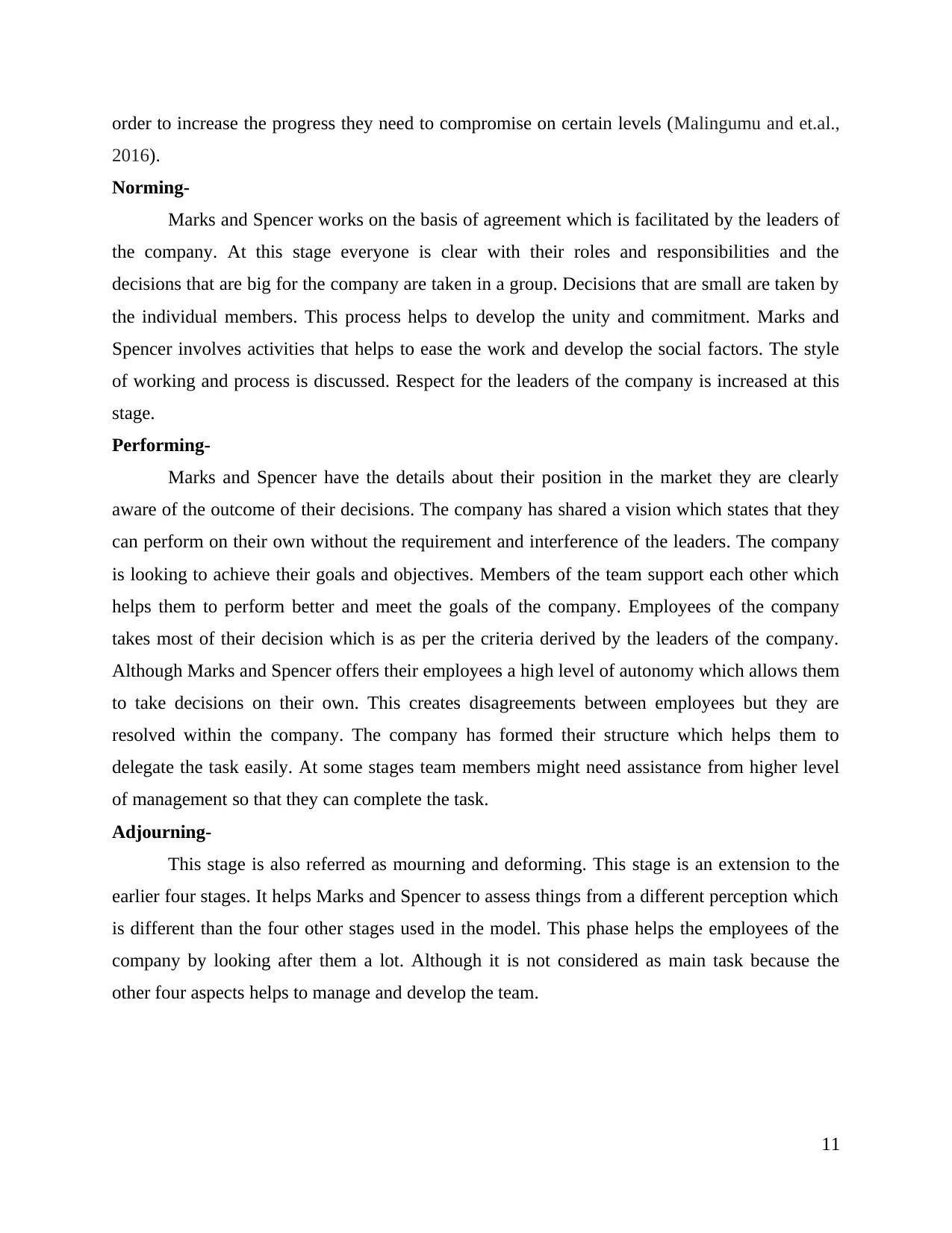
order to increase the progress they need to compromise on certain levels (Malingumu and et.al.,
2016).
Norming-
Marks and Spencer works on the basis of agreement which is facilitated by the leaders of
the company. At this stage everyone is clear with their roles and responsibilities and the
decisions that are big for the company are taken in a group. Decisions that are small are taken by
the individual members. This process helps to develop the unity and commitment. Marks and
Spencer involves activities that helps to ease the work and develop the social factors. The style
of working and process is discussed. Respect for the leaders of the company is increased at this
stage.
Performing-
Marks and Spencer have the details about their position in the market they are clearly
aware of the outcome of their decisions. The company has shared a vision which states that they
can perform on their own without the requirement and interference of the leaders. The company
is looking to achieve their goals and objectives. Members of the team support each other which
helps them to perform better and meet the goals of the company. Employees of the company
takes most of their decision which is as per the criteria derived by the leaders of the company.
Although Marks and Spencer offers their employees a high level of autonomy which allows them
to take decisions on their own. This creates disagreements between employees but they are
resolved within the company. The company has formed their structure which helps them to
delegate the task easily. At some stages team members might need assistance from higher level
of management so that they can complete the task.
Adjourning-
This stage is also referred as mourning and deforming. This stage is an extension to the
earlier four stages. It helps Marks and Spencer to assess things from a different perception which
is different than the four other stages used in the model. This phase helps the employees of the
company by looking after them a lot. Although it is not considered as main task because the
other four aspects helps to manage and develop the team.
11
2016).
Norming-
Marks and Spencer works on the basis of agreement which is facilitated by the leaders of
the company. At this stage everyone is clear with their roles and responsibilities and the
decisions that are big for the company are taken in a group. Decisions that are small are taken by
the individual members. This process helps to develop the unity and commitment. Marks and
Spencer involves activities that helps to ease the work and develop the social factors. The style
of working and process is discussed. Respect for the leaders of the company is increased at this
stage.
Performing-
Marks and Spencer have the details about their position in the market they are clearly
aware of the outcome of their decisions. The company has shared a vision which states that they
can perform on their own without the requirement and interference of the leaders. The company
is looking to achieve their goals and objectives. Members of the team support each other which
helps them to perform better and meet the goals of the company. Employees of the company
takes most of their decision which is as per the criteria derived by the leaders of the company.
Although Marks and Spencer offers their employees a high level of autonomy which allows them
to take decisions on their own. This creates disagreements between employees but they are
resolved within the company. The company has formed their structure which helps them to
delegate the task easily. At some stages team members might need assistance from higher level
of management so that they can complete the task.
Adjourning-
This stage is also referred as mourning and deforming. This stage is an extension to the
earlier four stages. It helps Marks and Spencer to assess things from a different perception which
is different than the four other stages used in the model. This phase helps the employees of the
company by looking after them a lot. Although it is not considered as main task because the
other four aspects helps to manage and develop the team.
11
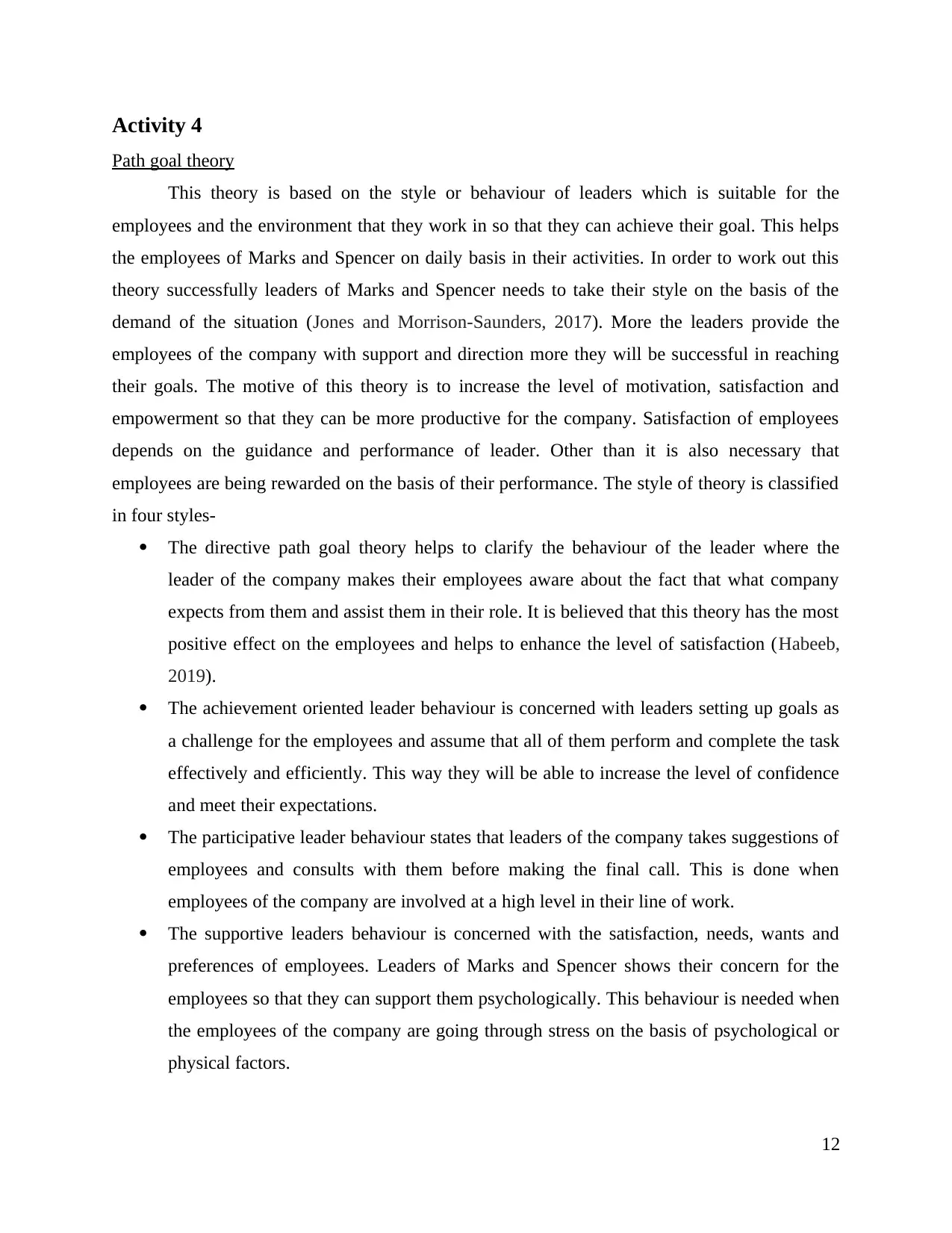
Activity 4
Path goal theory
This theory is based on the style or behaviour of leaders which is suitable for the
employees and the environment that they work in so that they can achieve their goal. This helps
the employees of Marks and Spencer on daily basis in their activities. In order to work out this
theory successfully leaders of Marks and Spencer needs to take their style on the basis of the
demand of the situation (Jones and Morrison-Saunders, 2017). More the leaders provide the
employees of the company with support and direction more they will be successful in reaching
their goals. The motive of this theory is to increase the level of motivation, satisfaction and
empowerment so that they can be more productive for the company. Satisfaction of employees
depends on the guidance and performance of leader. Other than it is also necessary that
employees are being rewarded on the basis of their performance. The style of theory is classified
in four styles-
The directive path goal theory helps to clarify the behaviour of the leader where the
leader of the company makes their employees aware about the fact that what company
expects from them and assist them in their role. It is believed that this theory has the most
positive effect on the employees and helps to enhance the level of satisfaction (Habeeb,
2019).
The achievement oriented leader behaviour is concerned with leaders setting up goals as
a challenge for the employees and assume that all of them perform and complete the task
effectively and efficiently. This way they will be able to increase the level of confidence
and meet their expectations.
The participative leader behaviour states that leaders of the company takes suggestions of
employees and consults with them before making the final call. This is done when
employees of the company are involved at a high level in their line of work.
The supportive leaders behaviour is concerned with the satisfaction, needs, wants and
preferences of employees. Leaders of Marks and Spencer shows their concern for the
employees so that they can support them psychologically. This behaviour is needed when
the employees of the company are going through stress on the basis of psychological or
physical factors.
12
Path goal theory
This theory is based on the style or behaviour of leaders which is suitable for the
employees and the environment that they work in so that they can achieve their goal. This helps
the employees of Marks and Spencer on daily basis in their activities. In order to work out this
theory successfully leaders of Marks and Spencer needs to take their style on the basis of the
demand of the situation (Jones and Morrison-Saunders, 2017). More the leaders provide the
employees of the company with support and direction more they will be successful in reaching
their goals. The motive of this theory is to increase the level of motivation, satisfaction and
empowerment so that they can be more productive for the company. Satisfaction of employees
depends on the guidance and performance of leader. Other than it is also necessary that
employees are being rewarded on the basis of their performance. The style of theory is classified
in four styles-
The directive path goal theory helps to clarify the behaviour of the leader where the
leader of the company makes their employees aware about the fact that what company
expects from them and assist them in their role. It is believed that this theory has the most
positive effect on the employees and helps to enhance the level of satisfaction (Habeeb,
2019).
The achievement oriented leader behaviour is concerned with leaders setting up goals as
a challenge for the employees and assume that all of them perform and complete the task
effectively and efficiently. This way they will be able to increase the level of confidence
and meet their expectations.
The participative leader behaviour states that leaders of the company takes suggestions of
employees and consults with them before making the final call. This is done when
employees of the company are involved at a high level in their line of work.
The supportive leaders behaviour is concerned with the satisfaction, needs, wants and
preferences of employees. Leaders of Marks and Spencer shows their concern for the
employees so that they can support them psychologically. This behaviour is needed when
the employees of the company are going through stress on the basis of psychological or
physical factors.
12
⊘ This is a preview!⊘
Do you want full access?
Subscribe today to unlock all pages.

Trusted by 1+ million students worldwide
1 out of 17
Related Documents
Your All-in-One AI-Powered Toolkit for Academic Success.
+13062052269
info@desklib.com
Available 24*7 on WhatsApp / Email
![[object Object]](/_next/static/media/star-bottom.7253800d.svg)
Unlock your academic potential
Copyright © 2020–2025 A2Z Services. All Rights Reserved. Developed and managed by ZUCOL.



